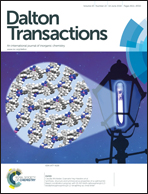A study on the synthesis of Ni50Co50 alloy nanostructures with tuned morphology through metal–organic chemical routes†
Abstract
NiCo bimetallic nanostructures with various morphologies have been synthesized using a broad range of solvents, surfactants and precursors that are available in the metal–organic chemical toolbox. Polygonal particles, nanowires and isotropic nanospheres have been obtained, among others. We describe the chemical pathways to achieve anisotropic growth either by an ‘in situ’ seed-mediated approach or by simply selecting suitable reaction media and growth modifiers. We describe the role of a variety of synthetic factors that influence the final shape of such an alloy material at the nanoscale. The alloying between cobalt and nickel is evidenced by XRD and HRTEM techniques. Room-temperature ferromagnetic behavior is observed for NiCo nanoparticles and high values for saturation magnetization and coercivity are recorded by SQuID magnetometry. The saturation magnetization value for the NiCo nanostructures is typically set between the corresponding “bulk” ones of cobalt and nickel metals. It is always comparable to the suggested value of the Ni50Co50 bulk alloy. The synthetic protocols derived from our extensive study are quantitative and versatile, allowing high reaction yields. Although macroscopic characterization techniques evidence the presence of a stoichiometric NiCo alloy, we show that in certain cases nanoscale characterization analyses are also needed for a more accurate evaluation of the alloy composition at the atomic level.


 Please wait while we load your content...
Please wait while we load your content...